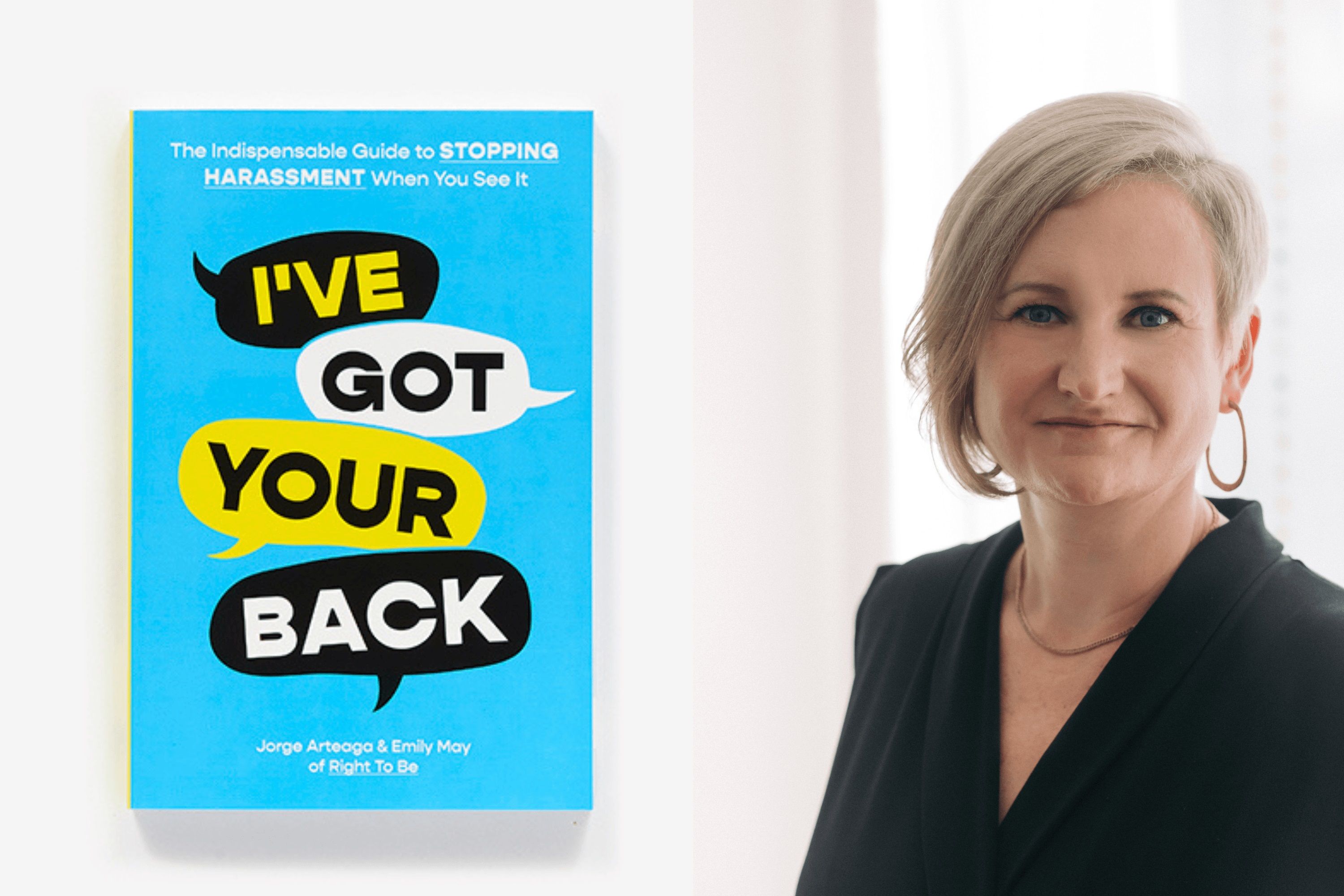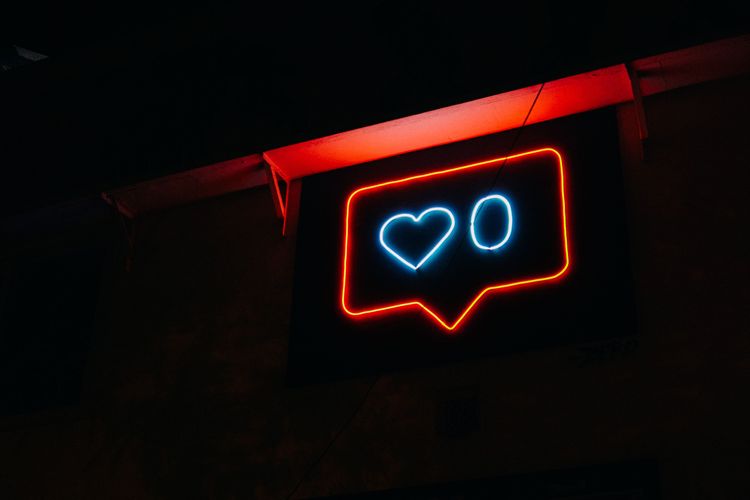
Oct 25, 2022, 1:00 am UTC
6 min
Created By
Q&A: Right to Be’s Emily May on why bystander intervention works
Emily May is on a mission to equip people to intervene in instances of harassment — on the street, online, or in the workplace. She is the co-founder and CEO of Right to Be (formerly Hollaback!), an organization that trains people to stand up for each other using the 5Ds of bystander intervention. Since 2005, she has heard thousands of stories of harassment and the trauma it can inflict. Yet, she believes that voice by voice, we can support each other and end harassment.
Earlier this year, May and Right To Be’s Jorge Arteaga published a book called "I’ve Got Your Back: The Indispensable Guide to Stopping Harassment When You See It."
wmnHealth spoke to Emily about the new book, the insatiable demand for bystander intervention training, why it works, and what’s next for Right to Be.
This interview has been edited for length and clarity.
wmnHealth: The Right to Be website reads: “When we intervene, we reduce the trauma of harassment for the person who was harmed (yes, harassment can cause trauma!)…." Is there a tendency to underestimate the toll harassment takes on people?
Emily May: People think of harassment as just the price you pay for being a woman. It’s very, very hard to find any woman, especially transgender, who has not experienced some form of harassment, from uncomfortable glaring, being followed, groped, all the way up through sexual assault or domestic violence.
You know, in Tina Fey's book, "Bossypants," which came out about 10 years ago, she tells the story of sitting in a racially and economically diverse room of folks. Together, they aligned on the first moment that they knew they were a woman. It wasn't the moment in which they won their first debate team competition. It wasn't even the moment when they got their first period. It was the moment when some guy said something nasty to them on the street.
So, for the longest time, people just dismissed harassment. But I think this generation and this decade is a decade in which people are saying, “Uh-uh. This actually isn't the price we should have to pay for being a woman.”
You’ve just co-written a book that covers the "5Ds" of bystander intervention and how they can be used in different contexts, including in public, in the workplace, and online. Why did you write it?
May: We couldn’t get the information out the door fast enough. At Right to Be, we do most of our bystander intervention training on Zoom, but we’re limited by that format. In about an hour, we can get across the basics of it, but a lot of folks really want to go deeper. They want to understand how public harassment intersects with workplace harassment intersects with online harassment. They want to understand how all their identities shape what the harassment experience feels like. They want to understand resilience tactics. They want to understand more about implicit bias. So we wrote the book for the people that want more.
I think this generation and this decade is a decade in which people are saying, "Uh-uh. This actually isn't the price we should have to pay for being a woman."
Right to Be trains about 100,000 people a year. What do you think is driving that demand?
May: I started doing this work in 2005. I was 24. And at that time, people understood that workplace harassment was an issue. Thank you, Anita Hill, and all of those amazing advocates! But they did not understand that harassment in public spaces was an issue. We chugged along for a while with people asking me things like, "Street harassment, what is that?” “Isn't that just compliments?” “Aren't you just taking it a little too seriously?” “Don't people just need to grow with thicker skin?"
Then the 2016 election happened and the rise of Islamophobic harassment. People really started paying attention to the ways in which words hurt people. Then in 2017, the #MeToo movement took off. All of a sudden, the conversation was not just about how physical forms of sexual violence were hurtful, but also about how we treat each other. That, too, can be traumatic. Then we started to see conversations about anti-Black and anti-Asian harassment. When identity after identity was targeted, it became clear that we were all at risk for this. We’ve all had some experience where we've been treated as less than — granted, some of us had a lot more of them than others. And I think people started to realize this is actually a significant problem.
You know, people used to tell me that the mission of our organization was too small to be sustainable because we were only focused on harassment. Now, people tell me the mission is huge and sprawling and impossible. Yet the mission has really been the same all along. What has changed is people’s perceptions. People are really opening their eyes to what's happening.
And yet, there are not a lot of solutions out there. Calling the police or reporting harassment to HR shouldn’t be the only choice. So people have started to look for other ways around it.

Listen to Emily May talk about coping with harassment and resilience strategies.

Let’s talk about one of those solutions. Why does bystander intervention work? What impact does it have on people who experience harassment?
May: We did a research study back in 2012 with Cornell University that did a content analysis of all the stories of harassment submitted to our website. Today, there are over 32,000 of them. What we learned is that there are different ways in which bystanders intervene and without some kind of training, bystanders have a 50-50 shot of either improving the situation or making it worse.
The good news is that even as little as a knowing glance can reduce the trauma related to harassment. This comes back to what we know about healing from trauma, right? That healing from trauma is about developing safety, narrative, and community. Safety comes from literally getting out of the situation to a safe place. The narrative comes when people start to share their stories — and, we also have data that shows that the act of sharing your story online through a website has a healing effect. And the community comes when the community shows up for you and has your back in these scenarios. That little knowing glance can be enough community for people to feel seen and heard.
What about the impact on the bystanders who intervene? Are there psychological benefits for them, too?
May: That's a really interesting question. We train over 100,000 people a year to address sexist harassment, racist harassment, ableist harassment, religious harassment, you name it. What we know is that about half the people that show up for our courses represent the people who are most impacted by that type of harassment. I think they do it because it's healing. It's a way of living through that trauma again and having it have a different outcome. But I don't think it's across-the-board healing. For some people, the act of witnessing harassment again can be so triggering. So as a bystander, you've got to know yourself and trust what your heart and your body are telling you in those moments.
Right to Be’s work also focuses on online harassment and its consequences. Are there material differences between street harassment and online harassment? And does bystander invention work for both?
May: The root causes are the same — racism, sexism, homophobia, ableism. But the expression is quite different. Street harassment can be one person or a group of people. But it's not hundreds of people all at once, as is sometimes the case with online harassment. Online harassment is also complicated by the fact that a fair amount of it is actually facilitated by robots. How do you deal with that?
Also, the ability for people who harass online to quickly mobilize so many other people, and the shaming effect of so many people being able to see your harassment, capture it, screenshot it, share it, adds a whole other level of shame and harm and confusion into the mix, right?
I think we're still really wrestling through the differences and searching for solutions on both fronts. What we've seen is that bystander intervention is an effective response to all forms of harassment and all forms of violence because — you know, I'll be the first one to say it — it's not innovative. Humans have got a lot of practice surviving this way.
All 5Ds — distract, delegate, document, delay, and direct — have applications to online harassment, as well as in the workplace. They need some adaptation, but the approaches are the same because these are approaches that have been tried and true throughout human history.
What we've seen is that bystander intervention is an effective response to all forms of harassment and all forms of violence because — you know, I'll be the first one to say it — it's not innovative. Humans have got a lot of practice surviving this way.
Now that the book has been published, what are Right to Be’s next priorities?
May: We really want to get bystander intervention training into schools. We are working on testing and piloting a curriculum that would scan from kindergarten to grade 12. Obviously, there's a lot of conversation about anti-bullying happening globally. But I think we need to go beyond telling kids that the only thing they can do to address it is to tell the teacher. We need a more diverse set of solutions. We need to help kids step into their own power, learn it early, practice it early, and bring it all the way through college, through jobs, and through the Internet so that it becomes the “stop, drop, and roll” of this generation.



